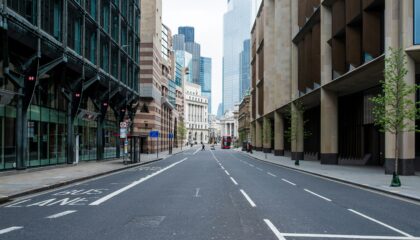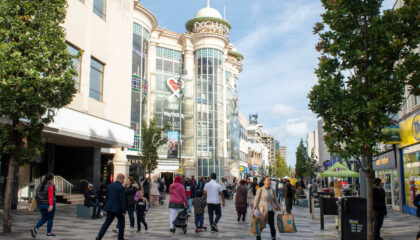Ferntastic: Natural History Museum reveals latest dinosaur resident, as newly transformed garden opens to public.
From 18 July 2024, the Natural History Museum opened the gates to its reimagined gardens, sponsored by Workman.
As part of its Urban Nature Project, the Museum has completed the transformation of its five-acre site to achieve an accessible, free-to-visit green space in the heart of London, where visitors can explore, rest, and connect with nature this summer.
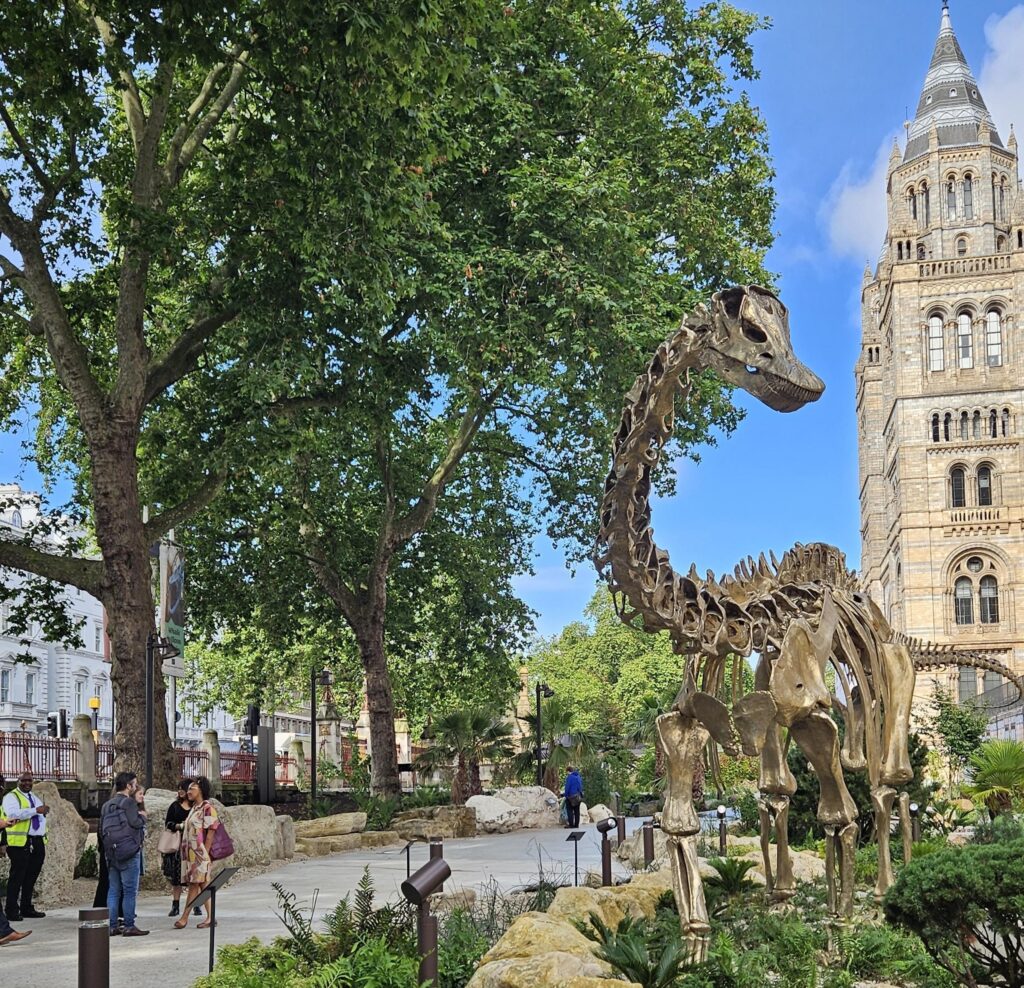
To mark the opening, a stunning brand-new bronze cast of the Museum’s much-loved Diplodocus has been revealed today [16 July], standing proud within the gardens. Following much speculation, the new dino resident’s name ‘Fern’ was unveiled by local school children (pictured below). Fern is supported by Kusuma Trust.
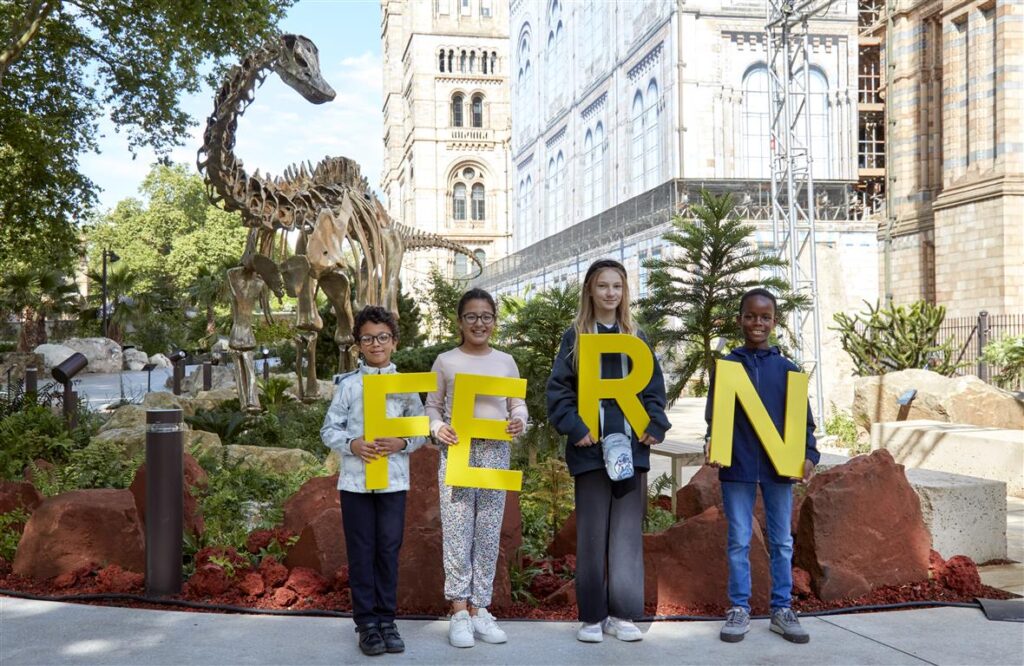
Image: © The Trustees of the Natural History Museum
The five acres of green space wrapping around the Museum’s much-loved building have been transformed into two outdoor living galleries ripe for exploration: the Nature Discovery Garden, supported by the Cadogan Charity, and the Evolution Garden. The gardens will be one of the most intensively studied urban nature sites globally, as part of the Museum’s national biodiversity movement.
Creating a sustainable design that works with the landscape and taking an ambitious approach to sustainable construction – from a diesel-free site and no waste sent to landfill to harvesting rainwater for the plants – has been at the heart of the redevelopment. The Museum’s Wildlife Garden was extended to double the area of native habitats within the grounds and the pond area has been increased by 60%, to better support the animal and plant life diversity.
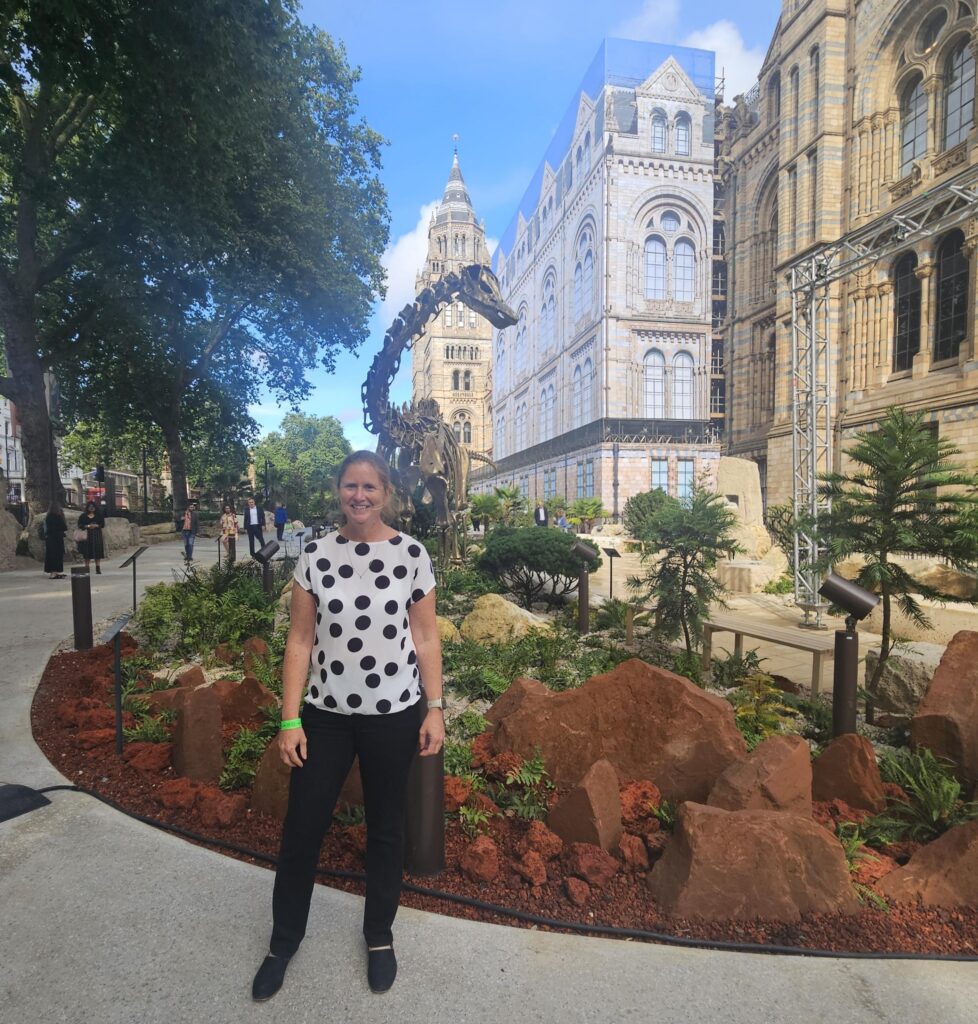
Vicky Cotton, ESG Director at Workman (pictured above left), said:
“We are delighted that the Natural History Museum has brought imagination and evolution to life, in this stunning example of urban biodiversity.
“We have been proud to support the Museum along this journey, which has delivered a sustainable design that chimes with its heritage landscape.
“The Museum’s ambitious yet sensitive approach to sustainable construction and commitment to conservation has been at the heart of the redevelopment.
“We are very much looking forward to seeing the garden come alive with plants and visitors this summer.”
Evolution Garden
In the Evolution Garden, visitors are invited to discover a journey from deep time to modern day. Learn about 2.7 billion years of history of our planet, told through the immersive timeline of plants, rocks of different geological periods from across the UK, and gleaming representations of reptiles, birds and mammals.
The Evolution Timeline, supported by the Evolution Education Trust, begins with an awe-inspiring canyon clad in ancient stone from Scotland.
As visitors emerge from the canyon into the Evolution Garden, they will be greeted by the graceful gaze of Fern. Don’t miss the garden’s second bronze dinosaur at Fern’s side, Hypsilophodon which was native to the UK. Both dinosaurs stand within the Jurassic Garden also supported by Kusuma Trust.
Benches nestled in the landscape throughout the gardens encourage visitors to take a moment to relax and enjoy the gardens. The Garden Kitchen, opening later in 2024, will also provide a welcome café break.
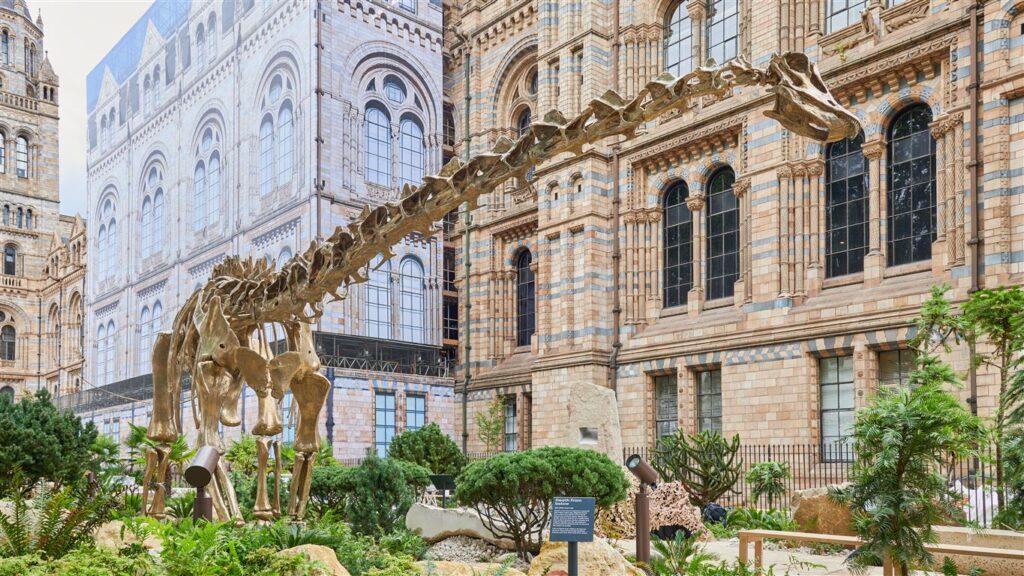
Image: © The Trustees of the Natural History Museum
Nature Discovery Garden
The Nature Discovery Garden is a space for visitors and scientists alike to find out more about the extraordinary wildlife on our doorsteps today.
Different habitats represent the rich biodiversity that can be found in the UK’s urban spaces. An accessible sunken pathway winds between the ponds, where frogs, newts, dragonflies and mandarin ducks have already been spotted making themselves at home.
As part of the garden, the Nature Activity Centre supported by Amazon Web Services (AWS) is a purpose-built space for learning about the urban nature on everyone’s doorsteps. It combines facilities for scientific work, a training space for future urban ecologists, and a hub for school workshops and family activities in the gardens.
Get involved
Explorers of all ages can get hands on with nature, from pond dipping to garden trails. An audio guide will bring the stories of the gardens to life, featuring interviews with the Museum’s scientists and poetry co-produced with blind and partially sighted young people.
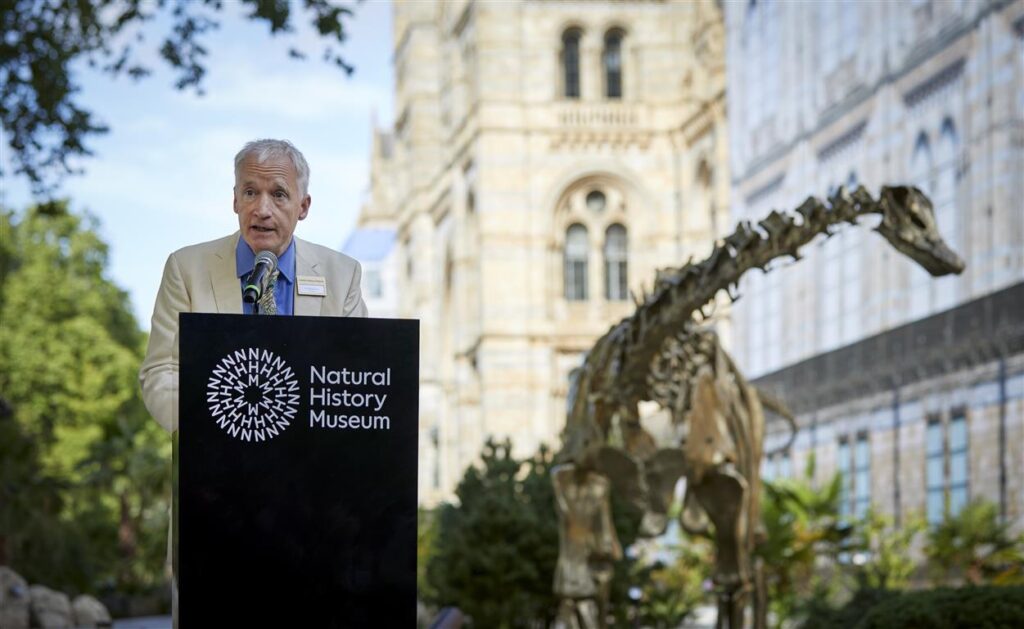
Image: © The Trustees of the Natural History Museum
Dr Doug Gurr, Director of the Natural History Museum (pictured above left), said:
“We are incredibly excited for visitors to get lost in nature and the story of our planet, stretching back 2.7 billion years, as they explore our completely transformed gardens this summer. Beneath the graceful gaze of our newest dinosaur.
“Fern, two immersive outdoor galleries are already teeming with wildlife. It’s the perfect place for all to connect with and learn about the nature on our doorsteps.
“We know that for people and planet to thrive, we must act to support urban nature recovery. As well as a new way for visitors to engage with the Museum, our reimagined gardens will play a vital role in understanding how nature in our towns and cities is responding to a changing planet, and how we can better safeguard it.”
Urban Nature Project
The transformation of the five-acre site is part of the Museum’s Urban Nature Project, responding to the urgent need to monitor and record changes to UK urban nature and support its recovery.
As well as a place for visitors to explore the diversity of life on Earth, the gardens are a living laboratory, and one of the most intensively studied urban nature sites of its kind in the world.
Scientists will observe wildlife and collect eDNA samples from the gardens. A network of 25 scientific sensors will also gather environmental and acoustic data – from underwater recordings in the pond and the buzz of insect wings to bird calls to traffic noise – to help them understand how urban nature is changing and what we can do to support its recovery. Once fully installed, the network of sensors in the gardens will collect up to 20 terabytes of audio data in the first year.
The Museum is working in partnership with global cloud provider, Amazon Web Services (AWS), to enrich and accelerate this vital work. The data collected from the gardens will be fed into the Museum’s new Data Ecosystem, a cloud platform built using AWS technologies. The Data Ecosystem helps the Museum’s team of scientists to collect, enrich and share multiple biodiversity data types alongside environmental data such as water chemistry, rapidly and accurately, from a range of sources.
To date, 57,000 visual wildlife observations have been uploaded to the Data Ecosystem, from historic data from the Museum’s wildlife gardens since 1995 right up to the transformed gardens opening in July 2024.
Tanuja Randery, EMEA Managing Director at Amazon Web Services, said:
“We are delighted to work with the Natural History Museum to use digital technology to build a better scientific understanding of the UK’s biodiversity and identify the solutions to support the recovery of nature in urban environments.
“The new Data Ecosystem, built on AWS, is already transforming and accelerating the Museum’s scientific research and community science capabilities, helping scientists to collaborate and access data through a secure and scalable platform. As the gardens open, we will continue to see the amount of data available to the Museum’s scientists grow in volume and richness.”
A wide variety of trusts, foundations, companies and individuals are supporting the Urban Nature Project including Amazon Web Services, The National Lottery Heritage Fund, Evolution Education Trust, The Cadogan Charity, Garfield Weston Foundation, Kusuma Trust, the Wolfson Foundation, Charles Wilson and Rowena Olegario, Royal Commission for the Exhibition of 1851, Clore Duffield Foundation, Workman LLP and Accenture.
A key strand of the project, Explore: Urban Nature, is delivered in partnership with the Garfield Weston Foundation, alongside all 12 museum and nature delivery partners. Since 2021, it has been providing school children aged 9-14 with exciting opportunities to dig into what urban nature is, what it does, how it’s changing, and what they can do to support it.
Over 2,000 people so far including Museum members, patrons, visitors and members of the local community have also supported the Urban Nature Project by purchasing one of the gift opportunities in the Gardens. This includes sponsoring a square metre of the garden and having a loved one’s name engraved on a brass railing or a bench plaque.
For more information and opportunities to support the public appeal, visit the website.
How to visit:
Visitors should book a free ticket in advance online for guaranteed entry to the Museum.

